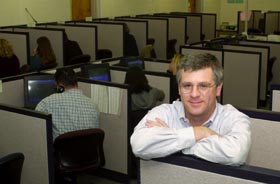|
This is an archived article.
For the latest news, go to the Advance
Homepage
For more archives, go to the Advance Archive/Search Page. |
||
|
UConn Poll Predicts Election Winners
- Again
In 20 years of polling, the UConn Poll has correctly called the winner in every gubernatorial, Senate and Congressional race in the state. This year was no exception. The poll, which reports the views of Connecticut voters during election campaigns, is conducted by the Center for Survey Research and Analysis. During this year's state electoral campaigns, the Center conducted 14 polls: eight on the gubernatorial campaign, and three apiece on the closely contested 2nd and 5th Congressional District races.
The final poll predicted a 54 percent vote for Republican John Rowland, with 36 percent for Democrat Bill Curry, or an 18-point spread; the final tally was 56 percent to 44 percent, for a 12-point spread. In the contest for the 5th Congressional District, the poll suggested a 54 percent to 36 percent lead for Nancy Johnson; she beat Democrat Jim Maloney 54 percent to 43 percent. And in the Simmons/Courtney matchup in the 2nd Congressional District, the poll was within 3 points, pointing to a 46 percent to 41 percent lead for Republican Rob Simmons over Democrat Joseph Courtney; the actual vote was 54 percent to 46 percent for Simmons. The UConn Poll has had a similar showing in previous elections. In 2000, the poll showed former vice president Al Gore ahead of George W. Bush by 17 points; he won by 16 points. In 1994, the poll said the race in the 2nd Congressional District between former U.S. Rep. Sam Gejdenson and Ed Munster was too close to call: Gejdenson subsequently won by just 21 votes. "We do the UConn Poll as a service to the state," says Ken Dautrich, an associate professor of political science and director of the Center for Survey Research and Analysis. He says independent voter surveys are integral to understanding political contests and protect against manipulation by candidates' campaigns: "If we weren't doing this, would you trust the campaigns to tell you who's ahead and who's behind and what issues are important?" Dautrich does not believe the UConn Poll affects voting patterns, and disagrees with critics who consider polling a corrupting influence in American politics. "I think you see more focus on polling because media see that as a way to add context to an election," he says. "Polls can do a good job of giving you a quick look at what the public is thinking, and people want to know what the scorecard is." Despite the UConn Poll's excellent record, Dautrich notes that polls are designed to tell researchers where public opinion is at on a particular day and that voter attitudes can shift quickly for a wide variety of reasons. Public opinion poll information provides a scientific way of determining how people feel about issues or political candidates, says Dautrich. It is also valuable in telling what the public knows about key issues. Although it is the UConn Poll that is best known, the Center for Survey Research and Analysis also conducts public opinion surveys on social, economic, as well as political issues. Clients now include federal, state and local government agencies, non-profit organizations, foundations, and UConn faculty whose academic research relies on survey data. The Center, which has 12 full-time employees and earns approximately $3 million a year, is currently conducting 20 surveys, including a two-year project on the Detroit public school system and surveys for state agencies, towns and other nonprofit organizations in Connecticut, and recently released studies with the Neag School of Education and with faculty from the economics department. Much of the UConn Poll is in the hands of 160 undergraduate and 15 graduate students. Graduate students are involved in designing surveys, drawing up samples, and analyzing the results. Undergraduates are individually trained to use the center's new computer system to make telephone calls and conduct interviews. "The students are a tremendous asset to our organization," says Dautrich. "Most professional polling companies don't have an articulate, college-educated group of people at their disposal to conduct surveys." CSRA recently overhauled its telephone interviewing center, installing a new computer-assisted telephone interview system that eliminated the need for paper and pencils. Questions are read off the computer screen, and answers, once typed in, are automatically tabulated at the same time the next question pops up on the screen. "This reduces error," Dautrich says, "expedites the interview, and reduces the time for computation of the results from two or three days to a matter of hours." |

